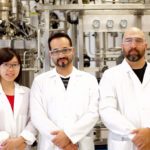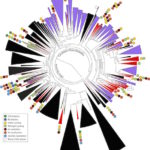 Scientists and software engineers at the U.S. Department of Energy (DOE)’s Joint BioEnergy Institute (JBEI) have developed a new -omics visualization tool, Arrowland, which combines different realms of functional genomics data in a single intuitive interface. The aim of this system is to provide scientists an easier way to navigate the ever-growing amounts of biological data generated by the postgenomic revolution. JBEI researchers hope that Arrowland will make it far easier for scientists to reach their next “a-ha!” moment in scientific discovery.
Scientists and software engineers at the U.S. Department of Energy (DOE)’s Joint BioEnergy Institute (JBEI) have developed a new -omics visualization tool, Arrowland, which combines different realms of functional genomics data in a single intuitive interface. The aim of this system is to provide scientists an easier way to navigate the ever-growing amounts of biological data generated by the postgenomic revolution. JBEI researchers hope that Arrowland will make it far easier for scientists to reach their next “a-ha!” moment in scientific discovery.
DOE JGI Summer Intern Author on GOLD Article
Kaushal Sharma, one of five Antioch High School rising juniors who participated in internships at the DOE Joint Genome Institute (JGI) this summer through the Biotech Partners program is now an author on a Nucleic Acids Research publication. The paper describes the version 6 data updates and feature enhancements to the Genomes OnLine Database (GOLD) administered by JGI. T.B.K Reddy, Kaushal’s mentor, described his student’s contributions as reviewing close to 3,800 metagenomes to verify geographic locations and assign latitude and longitude values “This exercise helped us in filling or updating geographic information for nearly 1,100 samples,” said Reddy. Kaushal also reviewed and assigned NCBI taxonomy name and IDs for nearly 20,000 public/private mtagenome biosamples in GOLD. “Besides these, he curated several small sets of phylogeny, biosample metadata tasks we assigned.” What did you do for your summer vacation?
Understanding the Genes Behind Some of Evolution’s Most Dramatic Changes
A research team led by biologist senior staff scientist Axel Visel, affiliated with the Environmental Genomics & Systems Biology Division, delved into the genetic basis for why snakes have no legs. The team’s research results demonstrated changes in a regulatory sequence associated with a major body plan transition and highlight the role of enhancers in morphological evolution.
Their findings, published in the journal Cell on October 20, have been widely covered in both national and international news media. The publication coincided with a Current Biology article in press (2016) by Leal and Cohn from the University of Florida who also looked at the mystery of how snake limbs vanished. This Washington Post article describes the approaches both teams took to come up with corroborating results.
New Bacteria Groups, and Stunning Diversity, Discovered Underground
Lawrence Berkeley National Laboratory (Berkeley Lab) and UC Berkeley researchers have uncovered new clues about the roles of subsurface microbes in globally important cycles. Jill Banfield, senior faculty scientist in the Earth & Environmental Systems Area and professor at UC Berkeley, led the research team that studied soil and water samples containing subsurface microbes collected at a Colorado River basin field site. DNA sequencing of these microbes was performed at the Joint Genome Institute (JGI), a DOE Office of Science User Facility.
As reported online October 24 in the journal Nature Communications, the scientists netted genomes from 80 percent of all known bacterial phyla, a remarkable degree of biological diversity at one location. They also discovered 47 new phylum level bacterial groups, naming many of them after influential microbiologists and other scientists, including ten in the Biosciences Area (with the form Candidatus Surnamebacteria). Phyla-level names have been proposed for Molecular Biophysics & Integrated Bioimaging Division’s Cheryl Kerfeld, Krishna Niyogi, and Jennifer Doudna; Environmental Genomics & Systems Biology’s Louise Glass, Kathleen Ryan, Steven Brenner, Mary Wildermuth, and Judy Wall; and the JGI’s John Vogel and Tanja Woyke. The researchers analyzed the metabolic interactions of these and other subsurface microbes to better understand their roles in ecosystem resilience. Read the full story at the Berkeley Lab News Center.
Davies and Mortimer at WEF’s Annual Meeting of the New Champions
Karen Davies, staff scientist in the Molecular Biophysics & Integrated Bioimaging Division, and Jenny Mortimer, Director of Plant Systems Biology at the Joint BioEnergy Institute (JBEI), were two of 50 extraordinary scientists under the age of 40 who were selected to participate alongside business and political leaders in the World Economic Forum’s 2016 Annual Meeting of the New Champions, which took place from June 26-28 in Tianjin, China.
To learn more about their experience joining a community of more than 1500 meeting participants from 90 countries, the Biosciences Communications Team asked them to answer a few questions about their participation and to shed some light on what is said to be “a true global experience addressing today’s unprecedented set of intertwined global challenges – economic, political, societal and environmental.”
- « Previous Page
- 1
- …
- 171
- 172
- 173
- 174
- 175
- …
- 213
- Next Page »
Was this page useful?







